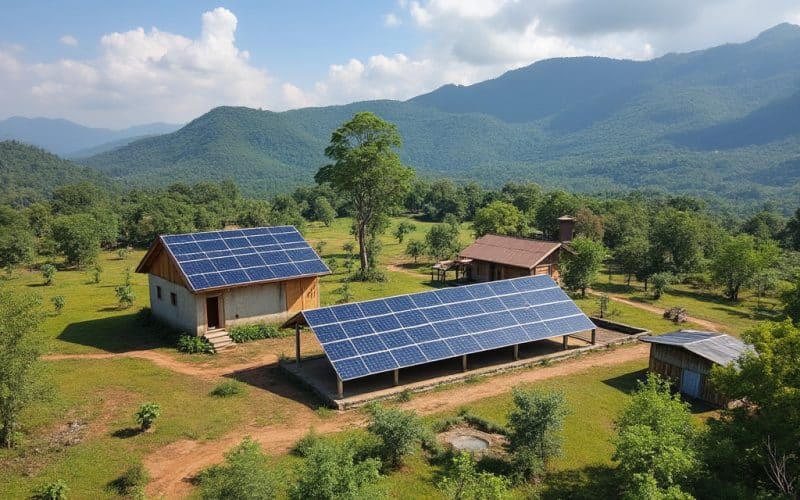
In the vast array of energy solutions, the concept of the microgrid has emerged as a transformative solution. This system offers localized, resilient, and often sustainable energy options, capable of operating independently from or in connection with the main power grid.
With more industries, communities, and governments seeking secure, eco-friendly, and cost-effective power, microgrids have gained attention for their unique ability to balance efficiency with environmental impact.
In this article, we’ll explore what microgrids are, their advantages and challenges, examples of successful implementations, and how they’re shaping the future of energy.
What is a Microgrid?
A microgrid is a localized energy system capable of generating, distributing, and managing power independently. It combines various sources of energy—such as solar panels, wind turbines, fuel cells, and battery storage—to create a small-scale version of the main grid. Unlike conventional energy systems, it can “island” itself, continuing to supply power during a main grid failure. This flexibility allows the system to support essential services during power outages, enhance energy security, and make use of renewable energy sources to reduce environmental impact.
"Solar and battery microgrids slash diesel and dollars in six remote towns."
— Climatehope (@Climatehope2) November 14, 2024
Reducing emissions, improving reliability with renewables. What's not to like? https://t.co/OX6xXSe5hI via @OneStepOffGrid
Advantages of Microgrids
They come with a suite of benefits that have made them essential in energy innovation. Here’s a breakdown of key advantages:
- Enhanced Reliability and Resilience
It ensure a reliable power supply even in adverse conditions. During grid outages, they can operate autonomously, providing power when it’s most needed. - Cost-Effective and Energy Efficient
It minimize transmission losses by generating power locally, leading to greater energy efficiency. With optimized power management, they also reduce costs, especially when integrating renewables with low operational expenses. - Environmental Sustainability
Many microgrids use renewable energy sources like solar and wind, which help reduce greenhouse gas emissions. The systems also align well with global sustainability goals, making them attractive for communities aiming for eco-friendly energy solutions. - Energy Independence
It offers localized control, allowing communities or facilities to operate without full dependence on the central power grid. This is especially advantageous in remote or disaster-prone areas. - Supporting the Main Grid
They contribute to grid stability by supplying power during peak demand times, thus lowering stress on the central system and preventing overloads.
Disadvantages of Microgrids
While these systems have numerous benefits, they also come with some challenges:
- High Initial Investment
The infrastructure costs for a system like this can be substantial. Investing in equipment like solar panels, batteries, and energy management software often requires financial backing that isn’t feasible for everyone. - Complexity in Design and Management
Designing a microgrid to meet specific needs requires expertise and intricate planning. Managing various energy sources, storage, and demand optimally can be challenging and requires specialized skills. - Regulatory Constraints
In some regions, laws and regulations hinder the integration of microgrids into the main grid or restrict selling excess power back to utility companies. These constraints can limit microgrid scalability and profitability. - Maintenance Demands
Microgrids, particularly those that incorporate renewables, need regular upkeep. Managing both traditional and renewable components can create ongoing maintenance expenses, making microgrids more resource-intensive over time. - Limitations in Energy Storage
Since many microgrids rely on battery storage, the limits of current battery technology—cost, lifespan, and capacity—can restrict a microgrid’s ability to supply uninterrupted power.
Real-Life Examples of Microgrids
Several successful microgrid implementations demonstrate the diversity and adaptability of these systems:
- Stone Edge Farm Microgrid, California, USA
This microgrid at Stone Edge Farm Winery integrates solar panels, microturbines, fuel cells, and battery storage, allowing the winery to operate independently from the main grid. This setup ensures resilience, reduces costs, and supports sustainable farming practices. - Gram Power Microgrid, Rajasthan, India
The village of Khareda Lakshmipura in Rajasthan implemented India’s first solar-powered microgrid in 2012. Using prepaid smart meters, this microgrid efficiently distributes electricity, offering on-demand power to the community while minimizing theft and waste. - Community Lighthouse Project, New Orleans, USA
To address hurricane-induced outages, the Community Lighthouse Project set up microgrids at churches across New Orleans. Equipped with solar panels and battery storage, these locations serve as community hubs for essential services, including medical device charging and air conditioning during blackouts. - Ragged Island Microgrid, Bahamas
After Hurricane Irma, Ragged Island adopted a solar-powered microgrid designed to withstand severe storms. This resilient microgrid reduces the island’s reliance on imported diesel, providing a sustainable and secure energy source for residents. - LIFE Factory Microgrid, Spain
Funded partially by the European Commission, this microgrid project integrates renewable energy into an industrial setting, showcasing how microgrids can enhance energy efficiency and reduce environmental impact in manufacturing.
The Future of Microgrids in Energy Transformation
Microgrids represent a major step forward in the way we produce, manage, and consume energy. Their ability to operate independently, optimize renewable sources, and support main grids during high demand makes them an attractive option for communities, industries, and governments alike. Despite the challenges of high initial costs and regulatory hurdles, microgrids continue to gain momentum worldwide as a sustainable and resilient energy solution.
As technology advances and the demand for clean energy grows, microgrids will likely become integral to the global energy landscape, offering a viable path toward a decentralized, efficient, and eco-friendly future.
In sum, microgrids are a powerful answer to many of today’s energy challenges, promising a more reliable, sustainable, and flexible future for power generation.
